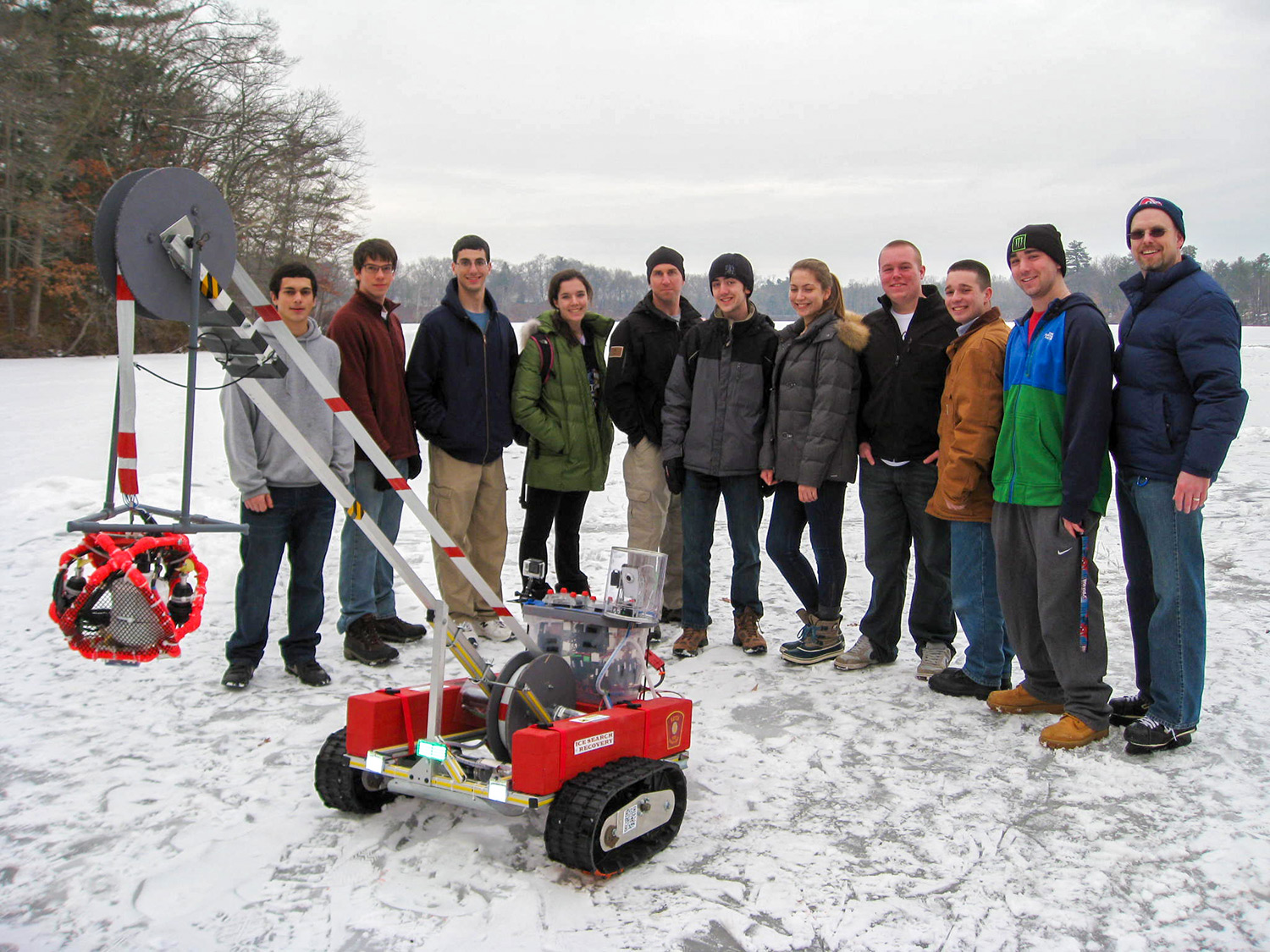
”Let's do this for real”
Doug Scott's innovative approach to teaching, inspired by a childhood filled with opportunities to fix and build things, enables students to solve real-world problems and seek patents for their solutions.
18 min read
Each month, our Journeys of Innovation series tells the stories of inventors or entrepreneurs who have made a positive difference in the world. Hear it in their own words or read the transcript below.
DOUG SCOTT: I remember sitting there at this local event before I found out that I won the presidential award. I'm going, you know, I'm a business undergrad from Framingham State [University] in Massachusetts. The pedigree was far above what I would consider myself near. It was nice to be nominated, and I made it this far, but I don't see it happening. So when I found out that I won, I was actually pleasantly surprised. It was a good feeling knowing that taking the crooked path was okay, and not having a clear view in mind of what I was supposed to do or what I should do was okay.
JOYCE WARD: In 2020, Doug Scott, a teacher at Hopkinton High School in Massachusetts, received the Presidential Award for Excellence in Mathematics and Science Teaching, the highest recognition for a K-12 STEM educator in the United States. Scott earned this award after many years of innovative teaching, which included working with students on robotics projects, one of which culminated in the receipt of a U.S. patent for Scott and the team.
I’m Joyce Ward from the United States Patent and Trademark Office. I recently spoke to Scott about his approach to teaching and how his earliest experiences with hands-on learning stayed with him along his “crooked path” to Invention Education.
It's a big accomplishment for a student to be able to say that they've done something for real.
DOUG SCOTT: A lot of the hands-on skills and ability to solve and work and fix things comes from my dad, certainly. The house that my parents are retired in now—we built that house when I was 10, 11, 12 years old. We were working on that house every weekend. That's what we did.
But also, I spent a lot of time with my uncle. He was a motorcycle guy. He was a biker, and we would work on motorcycles. We built sheds, we built go-carts, and his buddy Rusty—he was an inventor in his own right. I worked on projects with him that were amazing. He took two Ford Fiestas and turned it into a lawn tractor. He took the two engines and broke them all down and made a complete tractor system out of it. And then he had registered it so he could put it on the road and go plowing and all this stuff. And he used to joke, he'd say, “I'm the only guy in the neighborhood that can mow his lawn doing 60 miles an hour.”
I learned so much from those people and my father and all these different people that I worked with and was around all the time. All those hands-on components and skills, I've been able to pass on to kids.
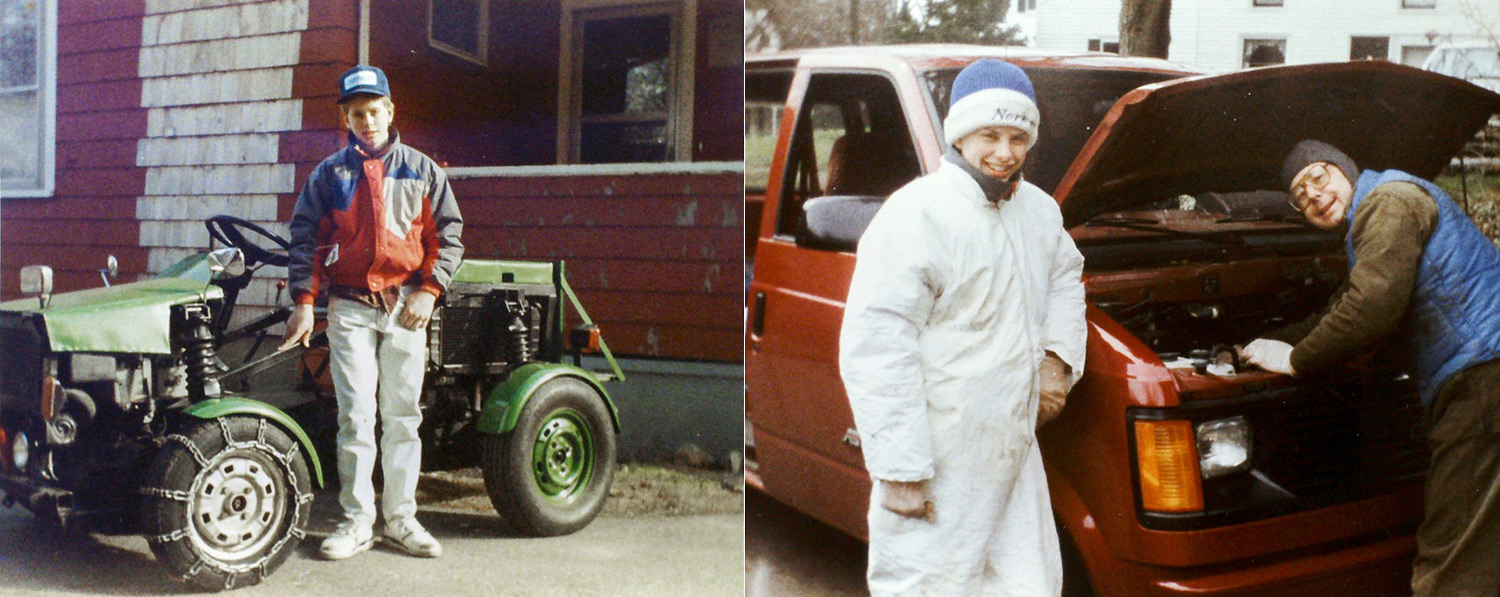
As a teenager, Scott (at left, age 13) often worked with his father, uncle, and family friend Rusty Forrest (at right, with Scott at age 14) on mechanical projects that have inspired his hands-on approach to teaching.
JOYCE WARD: Exposure to invention is critical to igniting young people's interest. As a teacher, Scott gives his students the types of project-based learning experiences that excited him as a child. Initially, though, he didn't plan to be a teacher. He shares how he found his way to the career that has become his passion.
DOUG SCOTT: It really started out through coaching. At the time, I was working with my father. He had a cleaning company, and I had gone through college. I was a business undergrad, and I really didn't have a whole lot of direction in which way I was gonna go. At the time, I thought I would just stay in the family business forever, and me and my brother would just keep that going. But I was coaching hockey at night with a friend of mine, and I enjoyed it. And at some point along the way, I started to have conversations with people about, “Boy, you know, I don't really know if I wanna be in this family business forever.”
My friend Mike Keegan, who I was coaching with at the time, was watching me interact with some players on the ice—some high school players. And after the practice, he said to me, “You know, you'd be a good teacher. You should look into that.” And I did. I looked into it, and I found a program at night at the local state college to get a teaching degree as a master's, and started doing that. That journey was kind of a strange one because I was living out of my work van pretty much. I would get up at about 6 in the morning. I'd go clean some office spaces and different things. I'd go 'till about noontime or 1 o'clock doing offices and houses and all this sort of stuff. I'd get back in my work truck, and I would drive up to Salem, Massachusetts, take a couple classes each day.
And the deal was this advisor that I had said I could get through this program in one year if I was willing to live poorly. So I did. And then I'd go back to work after that, and I'd work. And then the high school hockey practices at that time were at about 8:30 or 9 o'clock at night. I'd do that, go home, write papers and different things for the courses until about 1 in the morning. I'd get up and do it all over again.
And then along the way, I threw in student teaching in the daily mix. It was pretty hectic. But I was pretty driven, and as I was taking the classes and talking to different teachers and mentors, I really had a feeling that I'd like this. I'd like to teach.
I started out teaching Microsoft Word, Microsoft Excel, PowerPoint, Access database—teaching kids how to use all those programs. And we also had a class that I think really, really spring-boarded me into more inventive projects, which was—I was teaching a computer repair class. I was teaching kids how to get a certificate to be a computer technician. So I went out and took the test and did all that stuff, and I taught the kids how to do it. And what happened was I had a friend of mine that was a good mentor—this guy, Dan. And he was kind of showing me the ropes as I started out teaching.
And he told me, he said, “You know, whatever they tell you to do in all these theory classes and all this stuff,” he said, “don't do it.” He said, “Watch how some of these veteran teachers do things. Look around, and I'll show you the good teachers to learn from.” And he did. He pointed out certain people to watch, and he was right.
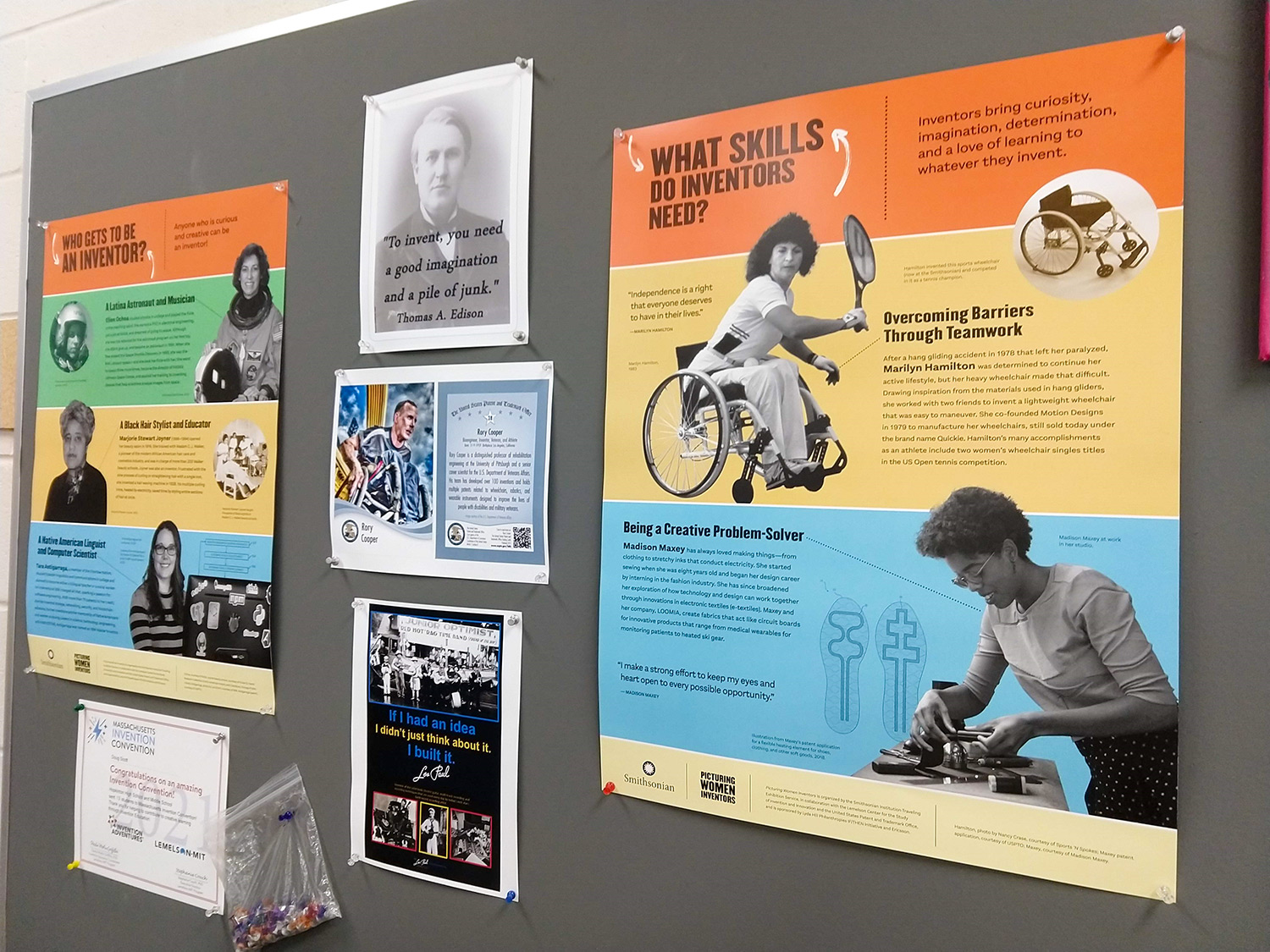
Inspirational posters on Scott's classroom wall feature innovators from diverse backgrounds. Enabling students to see themselves as inventors comprises a large part of Scott's teaching strategy.
JOYCE WARD: Dan wisely advised Scott to follow the lead of the more experienced teachers. But that's not the only thing he did. He left a copy of “Popular Mechanics” magazine featuring an underwater robot on Scott's desk, hoping it would inspire Scott to work with his students to build one. With that small gesture, Dan helped Scott turn another corner, and perhaps gave him a little push, on his journey as a teacher.
Doug Scott: I read the article. I got excited about it. I had a group of students build out this underwater robot, or ROV, and then it was like, okay, great. Well, we took it outside.
We looked around the pond, near the school, and the kids got to see fish, and it was very exciting. The kids got a kick out of it. And then it turned into, well, what can we really find with this thing? And I ended up having a conversation with a gentleman in New Hampshire, Dr. David Switzer—he's since passed—but at the time, he was the marine archeologist of the state of New Hampshire. He said, “You know, I found a steam wreck years ago in a lake in New Hampshire, and I haven't been able to locate it since.” He goes, “I had a group of students. We went down, took some photographs, and never could find it again. Can you take this machine that you've built with these kids, and can you find it for me?”
We ended up taking this really crude machine that didn't work well, and we threw it into the water a bunch of times. And I sent probably a thousand images to Dave, and he went through them all, and he sent one back, and he said, “That's it. You've found it.” I said, “Wow.” I said, “We really found something.” And he said, “Yes.” He said, “You found a hinge on a toolbox from this wreck that sank in 1915.”
And what happened was I got in touch with Woods Hole [Oceanographic Institution]. I got in touch with MIT [Massachusetts Institute of Technology], and I got in touch with all these different groups—NOAA [National Oceanic and Atmospheric Administration], all these places—and said, “Let's do this for real.“ And we had the kids build out an ROV that was much more capable. So we got all these retired people with their boats. And we organized a field trip up to the lake in early June of that following year.
I bussed 30 kids up, in like three hours, up into New Hampshire, with the vice principal and a guidance counselor. I got 10 boats out on the water and all this stuff, and it's this big operation, and we don't even know if we're gonna find anything. But we did. Kids put the robot down, and sure enough, it was the location. And we fully documented it. Turned over all the footage to Dave Switzer, to the local historical societies up there. And they're all excited.
The school came to me, and they said, “Can you do more of that?”
So long story short, what happened was we came back, we got a lot of notoriety from that project. The school came to me, and they said, “Can you do more of that?” We had a guy come in. His name was Justin Manley, from NOAA, and at lunch, he asked me, he said, “So what standards are you tying this all into?” And I just said to him straight out, I said, “I'm not.” And he said, “It's gonna work.” And I said, “You're right.”
So it was a chance—breaking a little bit of the rules—but it soon turned into multiple robotics teams, engineering projects, invention projects. I've had a pretty good impact on a couple communities with all that I've kind of picked up over the years.
You know, I just look back at it, and I can't imagine that they'll forget that field trip. That'll stick out. I think what they learned in that project and the way they had to work together to design and come up with their own system for an ROV—they learned a lot.
JOYCE WARD: The experience stuck not only with the students, but also with Scott. It inspired him to encourage the next class of students to take the idea of inventing for the real world even further. They collaborated with their local fire department on a project that led to participation in the White House Science Fair and ultimately a patent for the group.
Doug Scott: The kids wanted to do more ROV work. And then they had a meeting with the fire department, who wanted an ROV, and then it turned into an ROV that would search for drowning victims, in holes, in ice, in the Northeast, or in any cold area.
I said, “Well, what do you guys wanna do now?” And they said, “Well, let's get a patent because that'll really put a cap on this.” I said, “Yeah. Okay.” So they had filed a provisional patent, and we did that just to protect the kids' intellectual property.
Going through the patent process and applying to the USPTO for a utility patent—it was interesting. Got a lot of questions from adults early on. Are you trying to make money off this? Are the kids gonna make money off this? We never wanted to make money on it. We did it for educational purposes.
The kids went through the process. They were rejected twice—once for a set of drawings that, there was shading inside the drawing, and also the lines were too light. So they had to redo the patent drawings. And another time, they were rejected because someone had invented a device that was kind of a catch-all device. And it was really interesting because when we looked at it, the kids sat there, and they said, “This person hasn't actually created this in a prototype because we tried all these things that they say will work, and they don't work.” And I said, “Yeah, I know.” I said, “So how are you gonna differentiate yourself from this other device?” And what it came down to was this other person's invention could move vertically. And there was no mention of any horizontal movement on their underwater robot, and our students' could move horizontally. And that horizontal movement allowed them to be awarded a U.S. patent. That language in that claim that they edited was the difference.
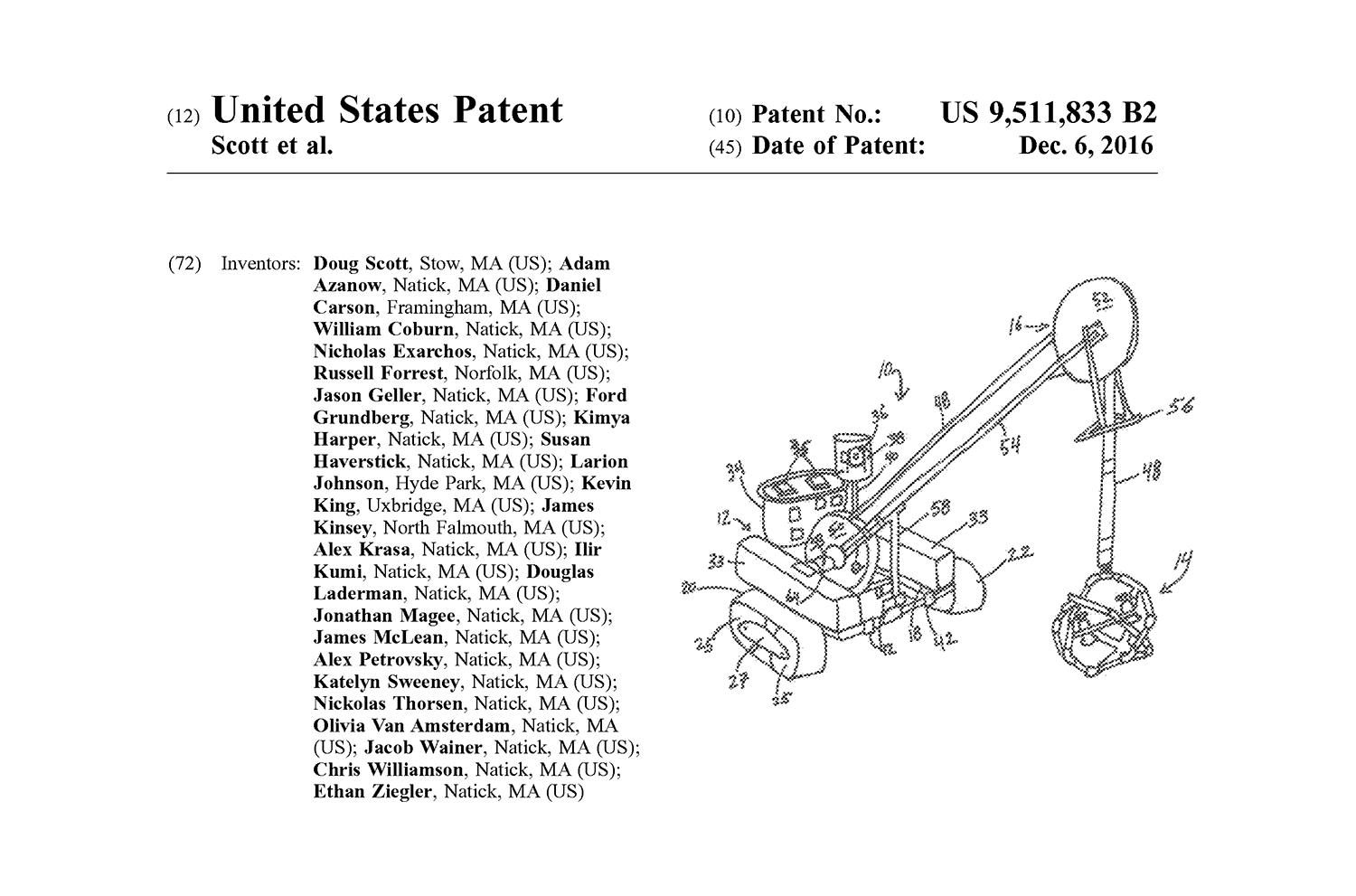
In 2016, Scott and his students received U.S. Patent No. 9,511,833 for their “multi-component robot for below ice search and rescue.“ The National Science and Technology Council's five-year STEM Education Strategic Plan, issued by the White House Office of Science and Technology Policy in 2018, highlighted the patent and Scott's work to introduce invention and intellectual property to his students.
JOYCE WARD: Scott continues to urge his students to identify real problems and invent real solutions. With his guidance, they've made connections in the local community that have led to life-changing experiences for them as young innovators.
DOUG SCOTT: We do a project now at Hopkinton High School with our fire department and police department. The way that that got started was kind of a funny interaction. I was actually being reprimanded by Tom Poirier—he's a local firefighter, great guy. He wasn't being nasty or anything, but I was taping a piece of paper to my door, which is against the fire codes. And he was doing the inspecting in the building. He said, “Do me a favor.” He said, “Take that paper off the door.” He goes, “You can't have paper on the door.” I said, “Yeah, I'll take the paper off the door, but you're gonna help me out.” And he goes, “What are you talking about?” I said, “You got a minute?” And he said, “Yeah.” And I told him about it. And he said, “Geez, that sounds pretty good.” And to his credit, he took me up on it [doing a project together]. And then once we started working with the fire department, the police didn't want to get left out because they're very competitive with each other. So we got the police to come in.
And then this year—I mean, just that little conversation and being willing to find that outlet or that person—we just had two students. They invented a specialized flashlight that uses a two-battery system. I'd never thought of this, but LED light bulbs that are now in flashlights—if your batteries get too low, it's not like the old days when an incandescent bulb would dim. These light bulbs just black out. They go right out. So if a police officer is out in the road at an accident at night, waving traffic by, all of a sudden, the light could just go out, unannounced or unwarned. And so these two girls, Nicolette and Lauren, came up with a flashlight system that uses two-battery systems. And you just flip a switch on the back, and it flips, switches over to the auxiliary power. And you've got another six or seven hours of battery life.
These two girls learned about this battery problem, and they identified the problem. They made sure it was a viable problem. And then they went through a process to develop solutions. They selected the best solution possible and went on to create their invention.
JOYCE WARD: Nicolette and Lauren exemplify the powerful influence educators like Scott have on female students who get involved, and stay involved, in STEM activities.
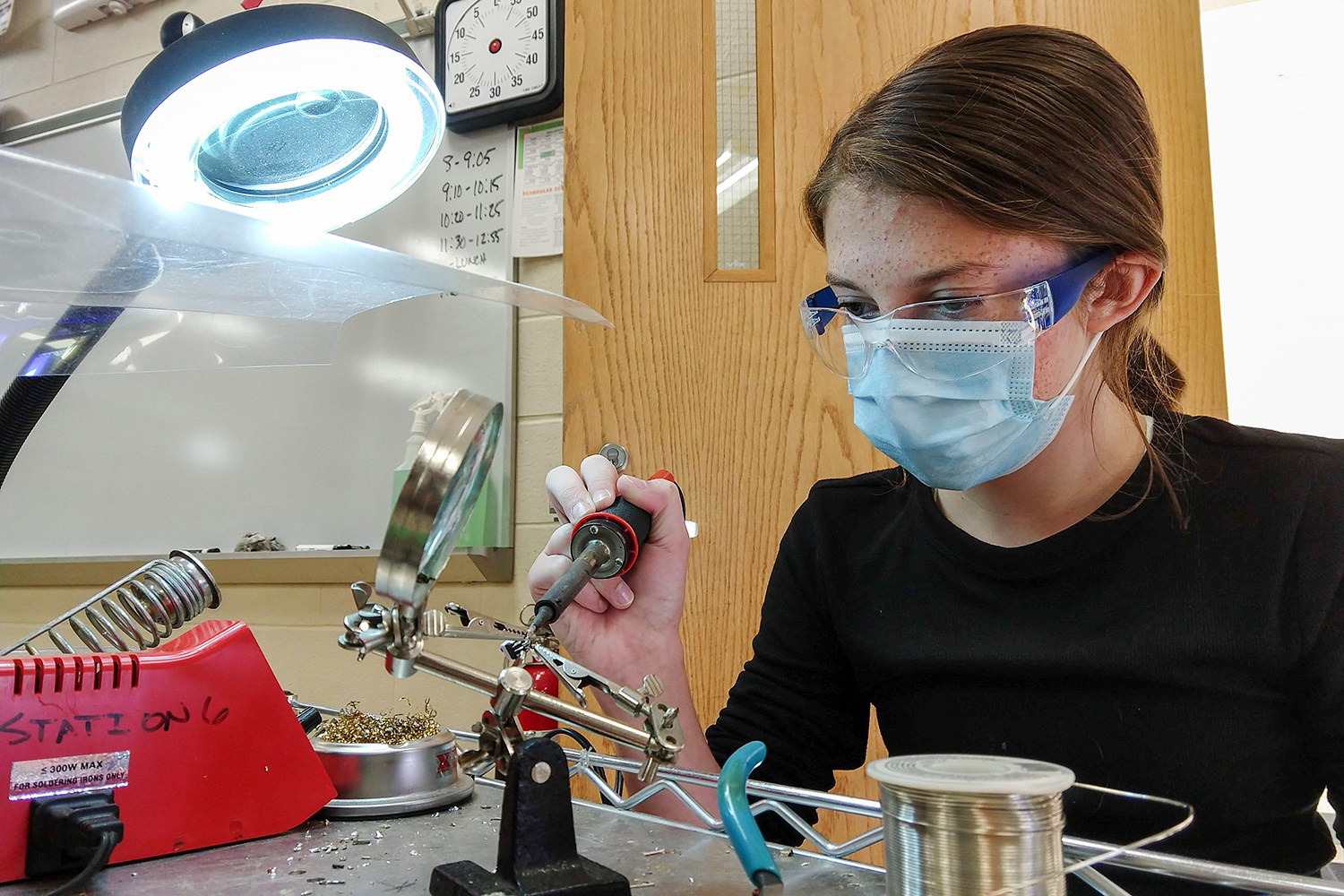
Scott encourages his students through project-based learning, including hands-on prototyping and building. He finds this approach particularly effective at engaging underrepresented students in STEM fields.
DOUG SCOTT: I'm looking at my rosters now for next semester, and I'll have, in a class of 24, let's say, I'll have 22 boys and like two girls. That's unfortunately common at the high school level. But if I see something like that—and I did with these two girls—I remember specifically having a conversation with them after the first class, because they all have this look on their face, like I don't belong here. I don't want to be here. This is uncomfortable. I just go right up to them, and I say, “I recognize what you do. You're the only two girls in this room. All I ask is you give me at least a week. If you don't like the class, leave,” I said, “but don't run to guidance today and switch out just because it's all boys. Just give me one week.”
And they stayed, and they're funny because now they want to come back. They're coming back for another class this year, and they stop by to say hello. And they are all excited about it. I found that Invention Ed. and teaching invention to students has that type of impact on all students. In my school district, the biggest underrepresented group in STEM are the female students.
JOYCE WARD: In addition to Scott's efforts to motivate more girls to invent, he incorporates lessons about intellectual property protection into his classes. In doing so, he prepares his students for future careers in STEM fields and instills confidence in their problem-solving abilities.
DOUG SCOTT: We have the kids file a simulated patent in class. So they kind of get an experience like that. Now this has all led into—this past year, we started doing it for real. We started a capstone class, and we now have five students signed up this year. We had four last year. And those students will actually go through the process of filing a provisional patent with the option to pursue a full U.S. patent if they like. It's a big accomplishment for a student to be able to say that they've done something for real.
We don't just talk about doing things. We do it. And so that's kind of how we roll. If you have an idea, and you want to develop it, let's go, which the engineers that visit always get a kick out of, because they'll sometimes say, “Yeah, that would've taken us three years of meetings to get to that point.” Whereas in a classroom, we don't have that kind of time. So if you have the idea on Tuesday, you can start building it on Wednesday.
Whatever you want to be, you're gonna have to solve problems. And at its core, teaching engineering—and teaching Invention Ed. specifically ... teaches these kids how to solve problems.
JOYCE WARD: Scott emphasizes the importance of making sure students understand how their work in the classroom relates to the real world.
DOUG SCOTT: Someday, you're gonna own a house, or rent an apartment, or whatever. You're gonna be living on your own. It'll be Sunday night, and some plumbing part on your toilet or your sink is gonna start leaking. And you're gonna become an inventor real fast because you can't get anybody to come fix it until Monday, and you're gonna have to solve a problem. So I don't care if you're gonna be an engineer. I don't care if you're gonna be a veterinarian. Whatever you want to be, you're gonna have to solve problems. And at its core, teaching engineering—and teaching Invention Ed. specifically, I think, is next-level—teaches these kids how to solve problems.
Very rarely have I seen any students have a eureka moment. It's basically a series of days where it's a lot of grinding and head banging and just working your way through the problem.

Scott joined his former students Ford Grundberg and Katelyn Sweeney at the Lemelson Foundation's 20th anniversary celebration at the Smithsonian National Museum of American History on September 18, 2015.
JOYCE WARD: Scott explains how more teachers can bring this mindset to the classroom.
DOUG SCOTT: It's one of those things where you have to let go of control. They [students] understand how they learn best. They're with themselves 24 hours a day, so they can learn anytime they want. They're only gonna have me for 50 minutes a day, or whatever it is. So if I can teach them how to learn and how to be inquisitive, and they find out that they are their best teacher, and I help them kind of find some things about themselves that help them become that good teacher of themselves, then they’re off, and they’re lifelong learners. And I think that would be the goal of education, I would hope.
JOYCE WARD: Doug Scott is an inspiration for students and teachers alike in the field of Invention Education. As a teacher himself, he channels his own experiences as a curious child shaped by family and friends who taught him critical lessons about making and building, and he passes those lessons on to his students. He hopes that they, like him, will become lifelong learners and problem solvers.
If you're an educator and you want to develop lessons that incorporate project-based learning models, innovation, and intellectual property, please consider applying for the USPTO's National Summer Teacher Institute, or see the links in the references section of this story.
From the USPTO, thanks for listening.
Credits
Produced by the USPTO Office of the Chief Communications Officer. For feedback or questions, please contact inventorstories@uspto.gov.
Interview by Joyce Ward. Story production by Christopher Dolce, Marie Ladino, Jay Premack, and Joyce Ward. Audio editing by Jay Premack. All photos courtesy of Doug Scott.
The image at the beginning of this story features Doug Scott (at right) with his Natick High School InvenTeam students in 2013. The team was invited to the White House Science Fair to demo their ROV, and they also received a patent for it.
The transcript has been edited for brevity.
References
Comins, Leah, ”Hopkinton High School Students Create Award-Winning Invention in Partnership with Hopkinton Police,” September 14, 2021.
inventEd., ”Natick High School InvenTeam.”
Lemelson Foundation, ”How One High School Teacher and an Invention Project Made All the Difference.”
Lemelson-MIT, Bee the Inventor (children's book co-written by Scott).
Lemelson-MIT, ”Natick High School InvenTeam's Path to U.S. Patent 9,511,833 B2.”
Natick High School, ”Natick High School SeaMoose Explores Stella-Marion” (footage of ROV shipwreck discovery).
Presidential Awards for Excellence in Mathematics and Science Teaching (recognition of Doug Scott).
Scott, Doug, mrscottbot blog.
USPTO, USPTO National Summer Teacher Institute (Scott is a 2014 alumnus).



